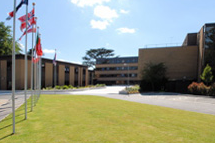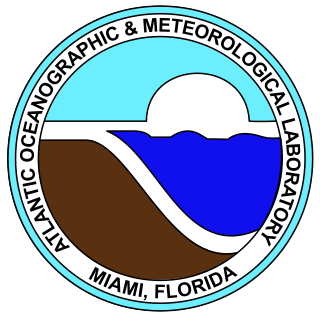Related Research Articles

The European Centre for Medium-Range Weather Forecasts (ECMWF) is an independent intergovernmental organisation supported by most of the nations of Europe. It is based at three sites: Shinfield Park, Reading, United Kingdom; Bologna, Italy; and Bonn, Germany. It operates one of the largest supercomputer complexes in Europe and the world's largest archive of numerical weather prediction data.

The instrumental temperature record is a record of temperatures within Earth's climate based on direct measurement of air temperature and ocean temperature, using thermometers and other thermometry devices. Instrumental temperature records are distinguished from indirect reconstructions using climate proxy data such as from tree rings and ocean sediments. Instrument-based data are collected from thousands of meteorological stations, buoys and ships around the globe. Whilst many heavily-populated areas have a high density of measurements, observations are more widely spread in sparsely populated areas such as polar regions and deserts, as well as over many parts of Africa and South America. Measurements were historically made using mercury or alcohol thermometers which were read manually, but are increasingly made using electronic sensors which transmit data automatically. Records of global average surface temperature are usually presented as anomalies rather than as absolute temperatures. A temperature anomaly is measured against a reference value. For example, a commonly used baseline period is the time period 1951-1980.

The United States National Climatic Data Center (NCDC), previously known as the National Weather Records Center (NWRC), in Asheville, North Carolina, was the world's largest active archive of weather data.

The global temperature record shows the fluctuations of the temperature of the atmosphere and the oceans through various spans of time. There are numerous estimates of temperatures since the end of the Pleistocene glaciation, particularly during the current Holocene epoch. Some temperature information is available through geologic evidence, going back millions of years. More recently, information from ice cores covers the period from 800,000 years before the present time until now. A study of the paleoclimate covers the time period from 12,000 years ago to the present. Tree rings and measurements from ice cores can give evidence about the global temperature from 1,000-2,000 years before the present until now. The most detailed information exists since 1850, when methodical thermometer-based records began. Modifications on the Stevenson-type screen were made for uniform instrument measurements around 1880.
The ECMWF reanalysis project is a meteorological reanalysis project carried out by the European Centre for Medium-Range Weather Forecasts (ECMWF). The first reanalysis product, ERA-15, generated reanalyses for approximately 15 years, from December 1978 to February 1994. The second product, ERA-40 begins in 1957 and covers 45 years to 2002. As a precursor to a revised extended reanalysis product to replace ERA-40, ECMWF released ERA-Interim, which covers the period from 1979 to 2019. A new reanalysis product ERA5 has recently been released by ECMWF as part of Copernicus Climate Change Services. This product has higher spatial resolution and covers the period from 1979 to present. Extension up to 1940 became available in 2023.

Oceanic and Atmospheric Research (OAR) is a division of the National Oceanic and Atmospheric Administration (NOAA). OAR is also referred to as NOAA Research.

The Atlantic Oceanographic and Meteorological Laboratory (AOML), a federal research laboratory, is part of the National Oceanic and Atmospheric Administration's (NOAA) Office of Oceanic and Atmospheric Research (OAR), located in Miami in the United States. AOML's research spans tropical cyclone and hurricanes, coastal ecosystems, oceans and human health, climate studies, global carbon systems, and ocean observations. It is one of seven NOAA Research Laboratories (RLs).

The Cooperative Institute for Research in Environmental Sciences (CIRES) is a research institute that is sponsored jointly by the National Oceanic and Atmospheric Administration (NOAA) Office of Oceanic and Atmospheric Research (OAR) and the University of Colorado Boulder (CU). CIRES scientists study the Earth system, including the atmosphere, hydrosphere, cryosphere, biosphere, and geosphere, and communicate these findings to decision makers, the scientific community, and the public.
The Climatological database for the world's oceans (CLIWOC) was a research project to convert ships' logbooks into a computerised database. It was funded by the European Union, and the bulk of the work was done between 2001 and 2003. The database draws on British, Dutch, French and Spanish ships' logbook records for the immediate pre-instrumental period, 1750 to 1850.

Christopher William "Chris" Landsea is an American meteorologist, formerly a research meteorologist with the Hurricane Research Division of the Atlantic Oceanographic and Meteorological Laboratory at NOAA, and now the Science and Operations Officer at the National Hurricane Center. He is a member of the American Geophysical Union and the American Meteorological Society.

The Atlantic hurricane reanalysis project of the National Oceanic and Atmospheric Administration seeks to correct and add new information about past North Atlantic hurricanes. It was started around 2000 to update HURDAT, the official hurricane database for the Atlantic Basin, which has become outdated since its creation due to various systematic errors introduced into the database over time. This effort has involved reanalyses of ship observations from the International Comprehensive Ocean-Atmosphere Data Set (ICOADS) as well as reanalyses done by other researchers over the years. It has been ongoing as of 2024.
Backtesting is a term used in modeling to refer to testing a predictive model on historical data. Backtesting is a type of retrodiction, and a special type of cross-validation applied to previous time period(s).
The NCEP/NCAR Reanalysis is an atmospheric reanalysis produced by the National Centers for Environmental Prediction (NCEP) and the National Center for Atmospheric Research (NCAR). It is a continually updated globally gridded data set that represents the state of the Earth's atmosphere, incorporating observations and numerical weather prediction (NWP) model output from 1948 to present.
Ocean reanalysis is a method of combining historical ocean observations with a general ocean model driven by historical estimates of surface winds, heat, and freshwater, by way of a data assimilation algorithm to reconstruct historical changes in the state of the ocean.
An atmospheric reanalysis is a meteorological and climate data assimilation project which aims to assimilate historical atmospheric observational data spanning an extended period, using a single consistent assimilation scheme throughout.
HadCRUT is the dataset of worldwide monthly instrumental temperature records formed by combining the sea surface temperature records compiled by the Hadley Centre of the UK Met Office and the land surface air temperature records compiled by the Climatic Research Unit (CRU) of the University of East Anglia.

The European Climate Assessment and Dataset (ECA&D) is a database of daily meteorological station observations across Europe and is gradually being extended to countries in the Middle East and North Africa. ECA&D has attained the status of Regional Climate Centre for high-resolution observation data in World Meteorological Organization Region VI.

Old Weather is an online weather data project that currently invites members of the public to assist in digitising weather observations recorded in US log books dating from the mid-19th century onwards. It is an example of citizen science that enlists members of the public to help in scientific research. It contributes to the Atmospheric Circulation Reconstructions over the Earth initiative. Data collected by Old Weather has been used by at least five different climate reanalysis projects, including HURDAT, SODA and ECMWF. In February 2013, the project was awarded the Royal Meteorological Society IBM Award for Meteorological Innovation that Matters.

The International Comprehensive Ocean-Atmosphere Data Set (ICOADS) is a digital database of 261 million weather observations made by ships, weather ships, and weather buoys spanning the years 1662 to 2007. The database was initially constructed in 1985 and continues to be expanded upon and updated on a regular basis. From the original data, gridded datasets were created. ICOADS information has been useful in determining the reliability of ship and buoy wind measurements, helping to determine temperature trends in the sea surface temperature field, and updating the Atlantic hurricane database.
Masao Kanamitsu was a Japanese and American atmospheric scientist working in the field of data assimilation. His research greatly influenced global and regional climate change studies including development of breakthrough reanalysis and downscaling datasets and weather forecasting studies. He was the co-author of one of the most cited geophysics paper in his time.
References
- 1 2 3 ACRE (2008-01-21). "About ACRE". The Met Office. Retrieved 6 May 2013.
- ↑ "Old weather "time machine" opens a treasure trove for researchers - Welcome to NOAA Research". research.noaa.gov. Retrieved 2019-10-09.
- ↑ Ian Simpson (Reuters) (2012). "US Looks to Old Arctic Ship Logs for Climate Change Clues". ScientificAmerican.com. Retrieved 2011-11-12.
{{cite web}}:|author=has generic name (help) - ↑ Rob Allan (2008-01-21). "WG1:Data Rescue". The Met Office. Retrieved 7 May 2013.
- 1 2 Rob Allan (21 January 2008). "Imaging and digitisation of historical instrumental marine and terrestrial weather observations". The Met Office. Retrieved 8 May 2013.
- ↑ Australian Meteorological Association Inc. "Sir Charles Todd Weather Folios 1879-1909". Australian Meteorological Association Inc. Archived from the original on 1 September 2013. Retrieved 9 September 2013.
- ↑ Rob Allan (2012). "'ACRE: European Mean Sea Level Pressure series back into the 18th Century". Philip Brohan (brohan.org). Archived from the original on 26 July 2014. Retrieved 9 May 2013.
- ↑ Zinta Zommers (22 March 2013). "Predicting future climate change may lie in the past". The Globe and Mail. Retrieved 9 April 2013.
- ↑ CIRES Press Release (9 April 2013). "New study gives first independent confirmation of global land warming". NOAA CIRES. Archived from the original on 13 April 2013. Retrieved 8 May 2013.
- ↑ Lucas Laursen (1 December 2011). "Extreme Weather More Frequent in Northern Europe". Earth Magazine. Retrieved 18 May 2013.
- ↑ Lauren Morello & Climatewire (10 February 2012). "NOAA Halts Reconstruction of Past Climate". Scientific American. Retrieved 19 May 2013.
- ↑ Janese Silvey (28 September 2011). "MU researchers examine 1911 day of wild weather". The Columbia Daily Tribune. Retrieved 9 April 2013.
- ↑ Jessie Lee & Mike Unscheid (January 2011). "January 1886 blizzards - 125 years later". KGYN Radio News. Archived from the original on 3 July 2013. Retrieved 17 May 2013.
- ↑ Earth Systems Research Laboratory (2012). "20th Century Reanalysis". National Oceanic and Atmospheric Administration. Retrieved 30 May 2013.
- ↑ Gustavo Herrera, Roberto; García-Herrera, Ricardo; Prieto, Luis; Gallego, David; Hernández, Emiliano; Gimeno, Luis; Können, Gunther; Koek, Frits; Wheeler, Dennis; Wilkinson, Clive; Del Rosario Prieto, Maria; Báez, Carlos; Woodruff, Scott. A Dictionary of Nautical Meteorological Terms: CLIWOC Multilingual Dictionary of Meteorological Terms; An English/Spanish/French/Dutch Dictionary of Windforce Terms Used by Mariners from 1750 to 1850 (PDF). CLIWOC. Archived from the original (PDF) on April 21, 2021. Retrieved February 15, 2014.